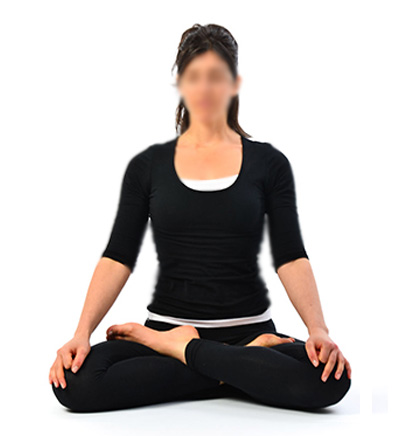
Posture:Padma-asana – The Lotus Posture
Translation:The Sanskrit word Padma means Lotus asana means throne. In hindu mythology, Goddess of Prosperity, Sri Lakshmi, sits atop a lotus flower.
Pronunciation:pud-mah-sa-na
Difficulty:(2-6) depending on flexibility of legs
Instructions:
- Sit on the floor with the legs stretched out straight in front.
- Bend the right knee and grasp the right foot with both hands and place it on top of the left thigh bringing the heel as close to the navel as possible
- Bend the left knee and grasp the left foot with both hands and place it on top of the right thigh bringing the heel as close to the navel as possible.
- Both knees should be on the ground and the soles of the feet are pointed upward. The spine is held straight but not rigid.
- The position of the legs may be switched after a period of time if the posture becomes uncomfortable.
Comments:
When in the padma-asana the hands can be placed in one of the following three positions:
- Place one hand on top of the other, both palms up, and rest the hands on the heels (this is known as the dhyana-mudra). This variation is recommended for meditation.
- Place the hands on the knees, palms down.
- With palms up, place the hands on the knees, form a circle with the thumb and forefinger and extend the remaining fingers straight ahead (this is known as the chin-mudra). Recommended for pranayama (Yogic breathing).
The padma-asana facilitates relaxation, concentration and ultimately, meditation. The posture creates a natural balance throughout the body/mind. When the knees are stretched enough to remain in the padma-asana without discomfort the posture creates a feeling of effortlessness and ease that will soothe the nervous system, quiet the mind and bring about the condition of one-pointedness.
Duration/Repetitions:
The length of time to sit in the padma-asana depends on your intention. In the course of a typical asana routine you might hold it for several minutes or until you experience discomfort in the legs. When used as a meditation posture you hold it for the duration of the meditation.
Variations:
If you find the padma-asana difficult or painful, can try the ardha padma-asana variation or half lotus posture (ardha means half). Instead of placing both feet on the thighs, only one foot is place on top of the opposite thigh and the other is place under the opposite thigh. Periodically alternate positions to allow both knees to be stretched. Those who are unable to do either variation of this asana comfortably should practice the baddha kona-asana.


